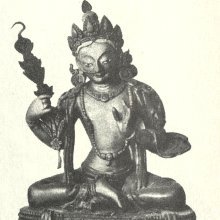Akarshani, Ākarṣaṇī: 8 definitions
Introduction:
Akarshani means something in Buddhism, Pali, Hinduism, Sanskrit. If you want to know the exact meaning, history, etymology or English translation of this term then check out the descriptions on this page. Add your comment or reference to a book if you want to contribute to this summary article.
The Sanskrit term Ākarṣaṇī can be transliterated into English as Akarsani or Akarshani, using the IAST transliteration scheme (?).
Images (photo gallery)
In Hinduism
Purana and Itihasa (epic history)
Source: archive.org: Shiva Purana - English TranslationĀkarṣaṇī (आकर्षणी) refers to “winning over (other men’s wives)”, according to the Śivapurāṇa 2.5.5 (“The Tripuras are fascinated).—Accordingly, as Sanatkumāra narrated to Vyāsa: “O sage, addressing the lord of the Asuras and the citizens thus, the sage with his disciples spoiled the Vedic rites in a determined manner. [...] The fascinated men practised rites of seduction and winning over (ākarṣaṇī) and made their artifices fruitful in gaining other men’s wives. The attendant maids in the haremss, the princes, the citizens and the ladies were perfectly enchanted by him. Thus when the citizens became averse to virtuous rites and actions, evil reigned supreme. [...]”.

The Purana (पुराण, purāṇas) refers to Sanskrit literature preserving ancient India’s vast cultural history, including historical legends, religious ceremonies, various arts and sciences. The eighteen mahapuranas total over 400,000 shlokas (metrical couplets) and date to at least several centuries BCE.
In Buddhism
Tibetan Buddhism (Vajrayana or tantric Buddhism)
Source: Wisdom Library: Tibetan BuddhismĀkarṣaṇī (आकर्षणी) is the name of Vidyārājñī (i.e., “wisdom queen”) mentioned as attending the teachings in the 6th century Mañjuśrīmūlakalpa: one of the largest Kriyā Tantras devoted to Mañjuśrī (the Bodhisattva of wisdom) representing an encyclopedia of knowledge primarily concerned with ritualistic elements in Buddhism. The teachings in this text originate from Mañjuśrī and were taught to and by Buddha Śākyamuni in the presence of a large audience (including Ākarṣaṇī).
Source: Wisdomlib Libary: VajrayoginiĀkarṣaṇī (आकर्षणी) is the name of a deity to be contemplated upon by a practicioner purifying his correspondences (viśuddhi), according to the 12th-century Abhisamayamañjarī. Ākarṣaṇī is alternatively known by the name Pāṇḍarā, one of the traditional consorts of the Buddha and a mother of the yogatantra system. The contemplation is prescribed as a preliminary ritual for a yogin wishing to establish, or reestablish the union with a deity.
Ākarṣaṇī is associated with the element water and the color red. She is to be visualised as assuming a kāpālika form, naked with loose hair and holding tantric attributes in their four arms.
Source: academia.edu: A Critical Study of the Vajraḍākamahātantrarāja (I)Ākarṣaṇī (आकर्षणी) is the name of a deity associated with the Bhūta (element) named Agni, according to the 9th century Vajraḍākatantra chapter 1.16-22.—Accordingly, this chapter proclaims the purity of the five components (skandha), five elements (bhūta) and five senses (āyatana) as divine beings [viz., Ākarṣaṇī].
Source: OSU Press: Cakrasamvara SamadhiĀkarṣaṇī (आकर्षणी) is associated with tejas-dhātu (element of fire), according to the Cakrasaṃvara Samādhi [i.e., Cakrasamvara Meditation] ritual often performed in combination with the Cakrasaṃvara Samādhi, which refers to the primary pūjā and sādhanā practice of Newah Mahāyāna-Vajrayāna Buddhists in Nepal.—Accordingly, “[...] Mohavajrī in the eyes. Dveṣavajrī in the ears. Īrṣyāvajrī in the nostrils. Rāgavajrī in the mouth. Sūryavajrī in touch. Aiśvaryavajrī in the seat of all senses. The element of earth, Pātanī. The element of water, Māraṇī. The element of fire (tejodhātu), Ākarṣaṇī. The element of wind, Padmanṛtyeśvarī. The element of Space, Padmajvālanī. Thus, the purity of the divinities in the seat of the elements”.

Tibetan Buddhism includes schools such as Nyingma, Kadampa, Kagyu and Gelug. Their primary canon of literature is divided in two broad categories: The Kangyur, which consists of Buddha’s words, and the Tengyur, which includes commentaries from various sources. Esotericism and tantra techniques (vajrayāna) are collected indepently.
Languages of India and abroad
Sanskrit dictionary
Source: Cologne Digital Sanskrit Dictionaries: Monier-Williams Sanskrit-English DictionaryĀkarṣaṇī (आकर्षणी):—[=ā-karṣaṇī] [from ā-karṣaṇa > ā-kṛṣ] f. a crooked stick for pulling down fruit etc., [cf. Lexicographers, esp. such as amarasiṃha, halāyudha, hemacandra, etc.]
Source: Cologne Digital Sanskrit Dictionaries: Yates Sanskrit-English DictionaryĀkarṣaṇī (आकर्षणी):—[ā-karṣaṇī] (ṇī) 3. f. A stick for pulling down fruit.
Source: DDSA: Paia-sadda-mahannavo; a comprehensive Prakrit Hindi dictionary (S)Ākarṣaṇī (आकर्षणी) in the Sanskrit language is related to the Prakrit word: Āgarisaṇī.
Sanskrit, also spelled संस्कृतम् (saṃskṛtam), is an ancient language of India commonly seen as the grandmother of the Indo-European language family (even English!). Closely allied with Prakrit and Pali, Sanskrit is more exhaustive in both grammar and terms and has the most extensive collection of literature in the world, greatly surpassing its sister-languages Greek and Latin.
See also (Relevant definitions)
Starts with: Akarshaniya, Akarshaniyate.
Ends with: Amritakarshani, Sarvatathagatakarshani.
Full-text (+25): Akarshin, Akarshini, Five Messengers, Agarisani, Pandara, Tejodhatu, Tejas, Janamohini, Makuta, Mohani, Kalyanamakuta, Ali, Jambhani, Siddhitva, Kali, Samsthana, Stambhani, Samayoga, Patani, Samsparsha.
Relevant text
Search found 1 books and stories containing Akarshani, Ā-karṣaṇī, A-karsani, A-karshani, Ākarṣaṇī, Akarsani; (plurals include: Akarshanis, karṣaṇīs, karsanis, karshanis, Ākarṣaṇīs, Akarsanis). You can also click to the full overview containing English textual excerpts. Below are direct links for the most relevant articles:
A Dictionary Of Chinese Buddhist Terms (by William Edward Soothill)
